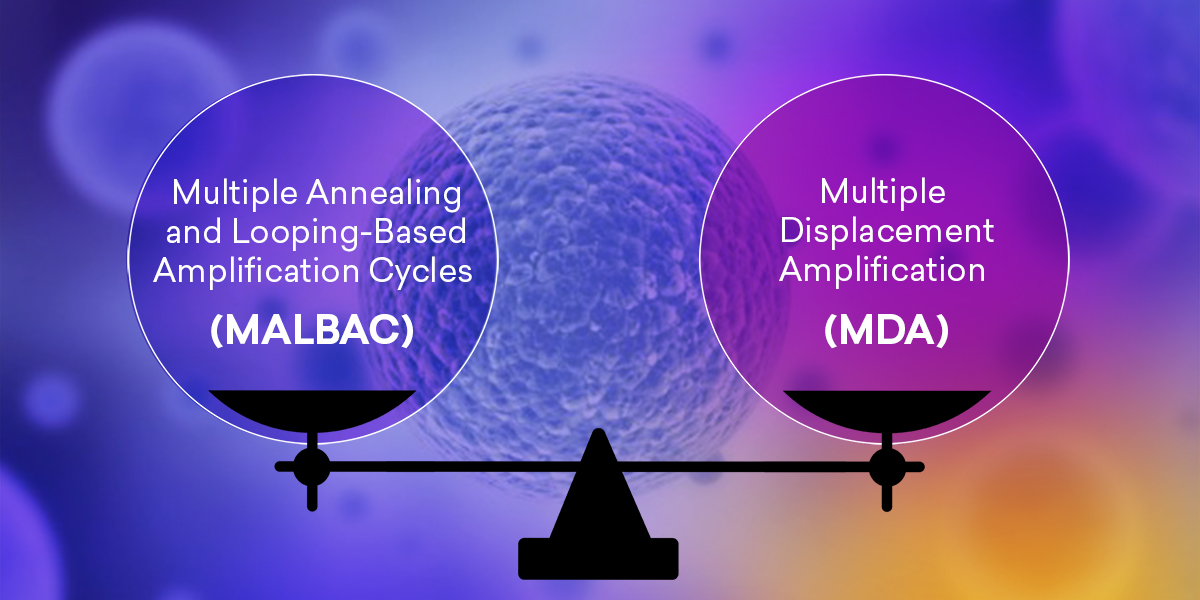Introduction
Whole genome amplification (WGA) methods are nothing short of revolutionary in their ability to capture minute amounts—sometimes coming from only a single cell— of genetic material and amplify it with high fidelity to generate enough DNA mass for researchers to work with.
Two of the most widely used WGA methods are multiple annealing and looping-based amplification cycles (MALBAC) and multiple displacement amplification (MDA). These methods are typically more accurate than PCR and were developed to address some of the shortcomings in earlier WGA methods, such as sequence loss, false positives and negatives, and technical artefacts such as amplification bias and random incorporation errors.1
Outlining Each WGA Method
Both of these methods are designed to amplify whole genomes and use randomers as part of their sequences to do that. 2
MALBAC is a quasi-linear, low-bias WGA method. MALBAC primers are designed to incorporate specific sequences at the ends of DNA amplicons that enable the formation of loops, which are not copied exponentially.
This method of amplicon looping mitigates overrepresentation of higher abundance templates, reducing amplification bias compared to MDA. Lower amplification bias also translates to better representation of GC-rich regions, as the competition for resources at early stages of priming and amplification does not lead to exponential quashing of amplification of these regions. Perhaps as a consequence of this property, MALBAC tends to yield a lower allelic drop-out rate compared to MDA.
MDA involves annealing random hexameric primers to DNA templates or denatured DNA, followed by strand displacement synthesis using phi29 polymerase, a high-fidelity enzyme.
This method allows researchers to generate larger sizes of samples with a lower error frequency. MDA also works at a constant temperature, as it is a type of isothermic amplification.
MALBAC and MDA are more recent developments within the WGA field, and both methods exhibit several advantages over older, more traditional PCR techniques.
Compared to degenerate oligonucleotide-primed PCR (DOP-PCR), MALBAC and MDA demonstrate improved coverage of the genome. MALBAC and MDA also provide better replication accuracy, meaning they lead to fewer allelic dropouts, fewer false positive results, and fewer false negative results. This makes these methods more accurate than traditional PCR methods for copy number variation (CNV) and single nucleotide variant detection.
MALBAC and MDA can each enable single-cell sequencing and sequencing for other samples with very little starting material. Plus, sequencing large genetic templates is possible with both.
Critical Considerations
MALBAC, while offering several advantages, also has limitations. This method uses thermostable Taq polymerase.3 Unfortunately, Taq polymerase is more prone to incorporation errors than phi29, which is commonly used in MDA. MALBAC’s complex, multi-step protocol also takes more time and involves temperature cycling and multiple stages. Although MALBAC can be used to achieve genome coverage up to about 90%4, some regions of the genome may be consistently underrepresented.
MDA also has some disadvantages. MDA remains prone to sequence-specific amplification bias because it proceeds through exponential amplification. This results in less genomic coverage uniformity than is typically obtained using MALBAC. MDA is also non-reproducible from cell to cell, probably because of the semi-stochastic nature of pre-exponential target amplification.
Which WGA Method and When?
Given the foundation of each method, there are several scenarios where one technique may be more beneficial than the other.
MALBAC is excellent for situations where researchers are looking at CNV. This WGA method gives samples that are more uniform and have higher levels of specificity.
In one study, researchers compared MALBAC and MDA to see which would more accurately identify genetic mutations to diagnose beta-thalassemia disorders. The study looked at one-, two-, and five-cell samples. At the single-cell level, MALBAC was more accurate because it had a lower allele dropout rate and had a reduced amplification bias in the fibroblasts. Both factors helped more accurately detect CNVs in the fibroblast samples.5
On the other hand, MDA is excellent for use in experiments involving mutation detection. The high-fidelity phi29 polymerase yields more accurate copies of double-stranded linear DNA, making it a great method for applications such as hemoglobin sequencing. One study found that MDA sequencing gave the exact same results as a standard column method when testing for mutations in globin genes in a hemoglobin gene sequencing procedure.6 MDA’s phi29 enzyme had a smaller error and less amplification bias than Taq polymerase for the same application.
An additional application where MDA is useful is single-nucleotide polymorphism (SNP) arrays.7 When researchers use MDA to amplify DNA and couple the process with SNP detection, the results are accurate for detecting aberrations in samples with only one cell or just a few cells.
What Does the Future Hold?
WGA is a valuable tool for genetic profiling of single cells and other low-input samples. But as next generation sequencing (NGS) technology progresses, there is an ever-pressing need to optimize and standardize WGA approaches to extract the most information from difficult sample types.
Currently, MALBAC and MDA stand out as powerful options, generating reliable results without the errors that can be caused by PCR methods. Excitingly, new WGA strategies such as Linear Amplification via Transposon Insertion (LIANTI) are giving us more precise ways of investigating single cell genomes.8 Because it is linear, LIANTI does not use exponential and nonlinear amplification, leading to less error propagation and more uniform amplification.
Another emerging technology is multiplexed end-tagging amplification of complementary strands (META-CS).9 This method almost entirely eliminates false positives and has shown promising results for single-nucleotide variant detection.
Conclusion
Optimizing and standardizing WGA approaches to maximize the information we can extract from challenging sample types is an ongoing challenge in NGS library prep. However, WGA is a valuable tool that mitigates these concerns. Whether you use MALBAC, MDA, or an even newer WGA method like LIANTI or META-CS will depend on your goals, the type of sample you have, and what genetic aspects you are looking for.
References
- https://doi.org/10.3390/ijms23158386
- https://teichlab.github.io/scg_lib_structs/methods_html/MALBAC.html
- https://www.news-medical.net/life-sciences/What-is-Taq-Polymerase.aspx#:~:text=Taq%20polymerase%20is%20the%20heat,of%20amplifying%20specific%20DNA%20sequences
- https://www.science.org/doi/10.1126/science.1229164
- https://www.ncbi.nlm.nih.gov/pmc/articles/PMC6817139/
- https://www.ncbi.nlm.nih.gov/pmc/articles/PMC1770312/
- https://pubmed.ncbi.nlm.nih.gov/22332743/
- https://pubmed.ncbi.nlm.nih.gov/28408603/
- https://pubmed.ncbi.nlm.nih.gov/33593904/

